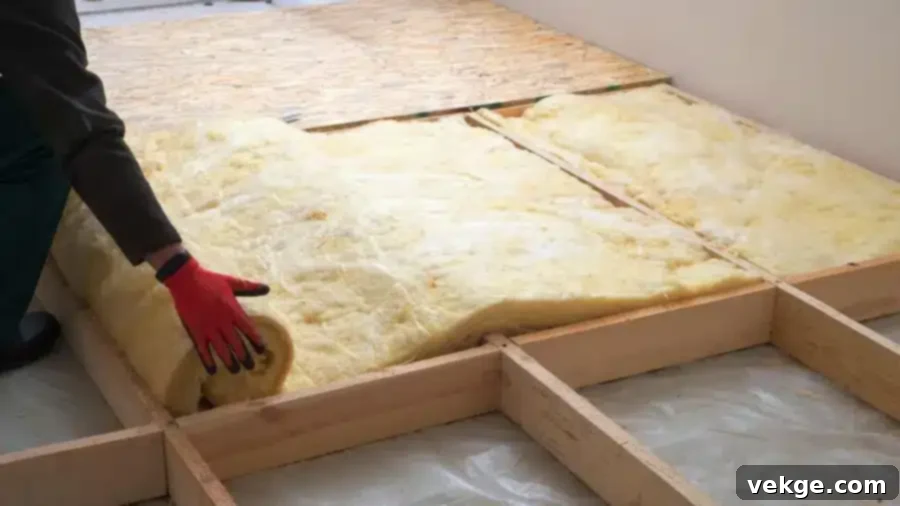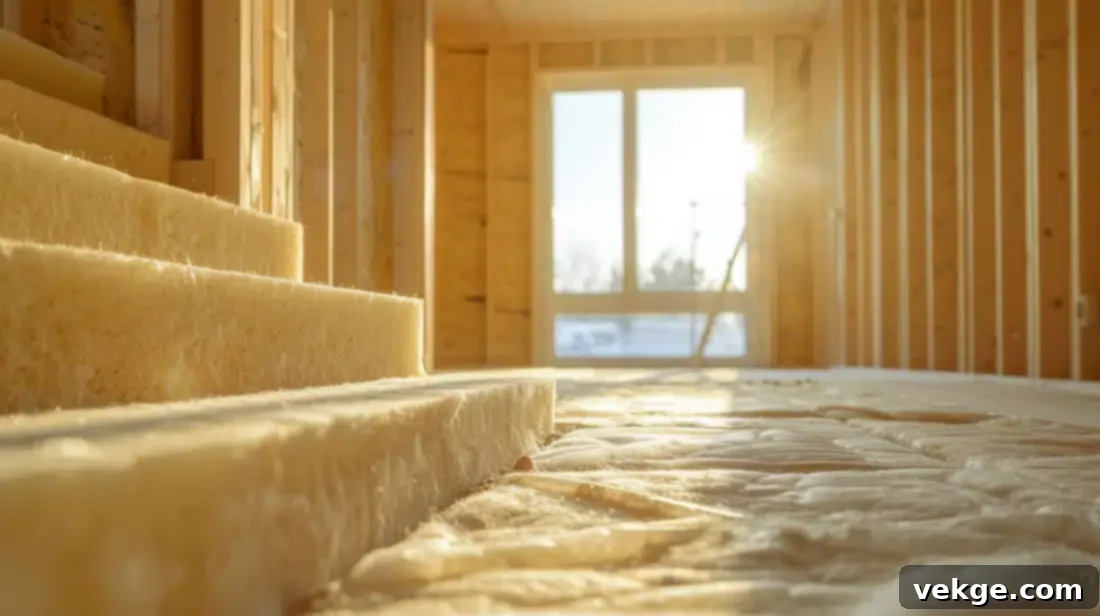Maximize Comfort & Efficiency: A Comprehensive Guide to Insulating Between Floors
Achieving optimal thermal effectiveness within any building fundamentally relies on robust insulation. While homeowners and builders instinctively prioritize insulating the roof and external walls to prevent heat loss or gain, other crucial areas within a home are often overlooked. One such area, frequently sparking debate and questions, is the necessity of insulating between floors.
The decision to install floor insulation is rarely straightforward. It involves weighing various factors, from enhancing energy efficiency and reducing noise transmission to preventing potential moisture issues. Understanding these nuances is key to making an informed choice that contributes to a more comfortable, quiet, and energy-efficient living environment. This comprehensive guide will delve into the compelling arguments both for and against insulating between floors, explore the critical considerations for selecting the right materials, and highlight the importance of professional advice to ensure the best outcome for your property.
Arguments in Favor of Insulating Between Floors

While the concept of insulating internal floors might seem unconventional to some, there are numerous, often vital, reasons why it can be a highly beneficial, if not essential, upgrade for your home. These benefits extend beyond mere thermal comfort, touching upon energy savings, noise reduction, and even structural integrity. Consider the following scenarios where floor insulation proves indispensable:
- Floors Above Unheated or Cold Spaces: One of the most common and critical applications for floor insulation is when a living space sits directly above an unheated or naturally cold area. This includes rooms positioned over ventilated crawl spaces, uninsulated basements, or attached garages. Without proper insulation, the cold air from these lower zones will readily transfer upwards, making the floor above consistently chilly and significantly increasing heating costs for the upper room. This thermal bridge creates discomfort and forces your heating system to work harder, leading to higher energy bills and reduced energy efficiency.
- Isolating Living Spaces from Unfinished Attics: In homes with an unfinished attic area directly above a living space, insulating between the floor joists of that attic floor (which is effectively the ceiling of the room below) is crucial. This helps to create a distinct thermal boundary, preventing heat from escaping into the unconditioned attic during winter or radiating down from a scorching attic in summer. This application ensures that the conditioned air within your living spaces remains isolated, maintaining stable indoor temperatures and reducing the energy load on your HVAC system.
- Cantilevered Floors and Protruding Rooms: For rooms or sections of a house that extend beyond the external wall below (known as cantilevered floors), insulation is absolutely essential. These extensions are particularly vulnerable to heat loss because they are exposed to outdoor temperatures on multiple sides, creating a significant thermal weak point in the building envelope. Insulating these floor cavities dramatically improves the energy performance and comfort of these specific areas, preventing them from becoming noticeably colder than the rest of the house.
- Slab Floors Constructed Directly on the Ground: Homes built with concrete slabs directly on the ground face unique challenges. Concrete is a poor insulator and can easily transfer ground temperatures into the living space, making floors cold and uncomfortable, especially in colder climates. Furthermore, uninsulated slabs are prone to moisture issues. Insulation beneath or on top of a slab floor is critical for creating a thermal break, preventing cold and dampness from permeating the home, enhancing comfort, and mitigating the risk of condensation and mould.
- Enhancing Acoustic Performance and Soundproofing: Beyond thermal considerations, floor insulation is an incredibly effective solution for reducing noise and sound transmission between different levels of a home. Whether it’s impact noise (footsteps, dropped objects) or airborne noise (voices, music) from a floor above or below, installing the right type of insulation can significantly dampen sound waves. This is particularly beneficial in multi-story homes, apartments, or buildings with home offices and entertainment rooms, contributing to a more peaceful and private living environment for all occupants.
- Improved Energy Efficiency and Reduced Utility Bills: By creating effective thermal barriers, floor insulation minimizes unwanted heat transfer, reducing the demand on your heating and cooling systems. This translates directly into lower energy consumption and significant savings on utility bills over the long term.
- Increased Property Value: An energy-efficient home with superior thermal and acoustic comfort is a more attractive prospect for potential buyers, potentially increasing its market value.
Arguments Against Insulating Between Floors and Important Considerations
While the benefits of floor insulation are substantial, it’s equally important to approach this decision with a clear understanding of potential drawbacks and critical considerations. Insulating floors inappropriately can sometimes lead to unintended consequences, highlighting the necessity of professional guidance.
The primary argument often raised against insulating internal floors, particularly those not directly adjacent to an unconditioned space, is that they are not traditionally considered part of the “building envelope” – the boundary separating conditioned indoor air from unconditioned outdoor air. In such cases, the heat lost from one floor might simply transfer to another conditioned floor, thus not truly being “lost” from the overall heated volume of the house. However, this argument mostly applies to floors *between* two heated living spaces. For floors over garages, crawl spaces, or unheated basements, they absolutely form part of the thermal envelope.
One significant concern with improperly installed floor insulation is the potential for moisture-related issues, primarily mould growth. If insulation is installed in a way that significantly lowers the temperature of the air cavity or structural elements below the dew point without adequate ventilation or vapor control, moisture can condense. This trapped moisture, especially in humid environments, can create ideal conditions for mould and mildew, leading to indoor air quality problems, material degradation, and health risks. For example, insulating a floor above a slightly damp basement without addressing the basement’s moisture issues first could exacerbate the problem by moving the condensation point into the floor assembly.
Moreover, insulation can sometimes obstruct the intended function of vapor barriers, or if a vapor barrier is improperly placed, it could trap moisture rather than prevent its entry. The interaction between insulation, air movement, and moisture dynamics is complex, emphasizing that a one-size-fits-all approach is not advisable.
Hence, it is absolutely vital to engage a qualified and accredited insulation specialist before making any modifications to your floors. An experienced professional possesses the expertise to assess your home’s specific characteristics, including its climate zone, construction type, existing moisture control strategies, and the intended use of the spaces involved. They can accurately determine if your home truly requires insulation between floors and, if so, the most appropriate type and installation method to avoid complications. A knowledgeable insulation contractor will also know the exact placement for insulation and any necessary vapor barriers without inadvertently disrupting the building’s existing thermal or moisture control systems.
Choosing the Right Floor Insulation: Materials and Methods

Selecting the appropriate type of floor insulation is just as crucial as the decision to insulate itself. The ideal material depends on various factors, including the floor’s construction, the space below it, local climate conditions, budget, and specific goals (e.g., thermal performance, soundproofing, moisture resistance). In colder climates, such as the UK, cold concrete floors are a familiar discomfort during winter, often retaining moisture and becoming a long-term maintenance issue. The right insulation can remedy these problems effectively.
Here’s an overview of common floor insulation types and their applications:
- Spray Foam Insulation: Often endorsed for its superior performance, spray foam (both open-cell and closed-cell) is an excellent choice for floors.
- Expansive Property: One of spray foam’s most significant advantages is its ability to expand dramatically (up to 100 times its original size for open-cell) upon application. This characteristic allows it to completely fill all voids, crevices, and gaps within floor joist cavities, creating an exceptionally airtight seal. This eliminates air leakage, which is a major source of heat loss/gain, and prevents thermal bridging, making it an incredibly material-efficient and effective choice for maximizing energy efficiency.
- Authentic Sound Barrier: By filling all cavities and creating a dense, seamless layer, spray foam acts as an authentic and highly effective sound barrier. It significantly dampens both airborne noise (voices, music) and impact noise (footsteps), aligning perfectly with the goal of soundproofing and creating quieter internal spaces. Closed-cell foam, in particular, offers superior sound blocking due to its density.
- Excellent Thermal Performance: Most crucially, spray foam insulation provides exceptional thermal performance with a high R-value per inch. If your upper floor is over a cold, unheated space like a garage or a chilly crawl space, spray foam will dramatically resolve the discomfort of frigid floors during winter and help maintain consistent temperatures year-round. Closed-cell foam also offers inherent moisture resistance, which is beneficial in damp environments.
- Durability and Air Sealing: Spray foam creates a durable, long-lasting barrier that resists settling, ensuring its effectiveness over time. Its air-sealing properties also contribute to improved indoor air quality by preventing drafts and the infiltration of pollutants.
- Professional Installation: While highly effective, spray foam requires professional installation due to the specialized equipment and expertise needed for proper mixing and application.
- Rigid Board Insulation (XPS, EPS, PIR): These foam boards offer high R-values and are excellent for insulating under concrete slabs, within subfloors, or in joist cavities. They are moisture-resistant and provide structural stability. XPS (extruded polystyrene) and EPS (expanded polystyrene) are common for slab insulation, while PIR (polyisocyanurate) offers some of the highest R-values.
- Mineral Wool (Rock Wool or Slag Wool): Available in batts or rolls, mineral wool is known for its excellent thermal and acoustic properties. It’s naturally fire-resistant and can be a good choice for insulating between floor joists, especially where sound attenuation is desired.
- Fiberglass Batts: A common and cost-effective option, fiberglass batts can be installed between floor joists. While good for thermal insulation, their acoustic performance is moderate, and careful installation is needed to avoid gaps and ensure full contact.
- Cellulose Insulation: Made from recycled paper products treated for fire resistance, blown-in cellulose is an eco-friendly option that can conform well to irregular spaces, providing good thermal and acoustic performance.
The choices for floor insulation, and the installation process itself, can seem daunting given the various materials, their specific properties, and the technical nuances involved. This complexity further underscores the wisdom of hiring a licensed and experienced contractor. A professional can not only recommend the most suitable insulation type for your specific needs but also ensure it is installed correctly, avoiding common pitfalls such as thermal bridging, moisture trapping, and inadequate air sealing. Investing in professional expertise guarantees that your floor insulation project achieves its desired benefits—enhanced comfort, superior energy efficiency, and effective sound control—without compromising the integrity or health of your home.
